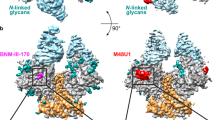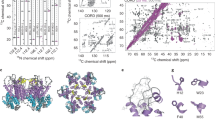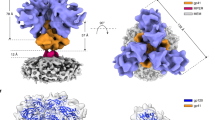Abstract
The solution structure of cyanovirin-N, a potent 11,000 Mr HIV-inactivating protein that binds with high affinity and specificity to the HIV surface envelope protein gp120, has been solved by nuclear magnetic resonance spectroscopy, including extensive use of dipolar couplings which provide a priori long range structural information. Cyanovirin-N is an elongated, largely β-sheet protein that displays internal two-fold pseudosymmetry. The two sequence repeats (residues 1–50 and 51–101) share 32% sequence identity and superimpose with a backbone atomic root-mean-square difference of 1.3 Å. The two repeats, however, do not form separate domains since the overall fold is dependent on numerous contacts between them. Rather, two symmetrically related domains are formed by strand exchange between the two repeats. Analysis of surface hydrophobic clusters suggests the location of potential binding sites for protein–protein interactions.
This is a preview of subscription content, access via your institution
Access options
Subscribe to this journal
Receive 12 print issues and online access
$189.00 per year
only $15.75 per issue
Buy this article
- Purchase on Springer Link
- Instant access to full article PDF
Prices may be subject to local taxes which are calculated during checkout






Similar content being viewed by others
References
Freed, E.O. & Martin, M.A. The role of human immunodeficiency virus type I envelope glycoproteins in virus infection. J. Biol. Chem. 270, 23883–23886 ( 1995).
Wilkinson, D. HIV-1: cofactors provide the entry keys. Curr. Biol. 6, 1051 –1053 (1996).
D'Souza, M.P. & Harden, V.A. Chemokines and HIV-1 second receptors - confluence of two fields generates optimism in AIDS research. Nature Med. 2, 1293–1300 (1996).
Boyd, M.R. et al. Discovery of cyanovirin-N, a novel human immunodeficiency virus-inactivating protein that binds viral surface envelope glycoprotein gp120: potential applications to microbicide development. Antimicrob. Agents Chemother. 41, 1521–1530 (1997).
Mori, T. et al. Analysis of sequence requirements for biological activity of cyanovirin-N, a potent HIV-inactivating protein. Biochem. Biophys. Res. Comm . 238, 218–222 ( 1997).
Boyd, M.R. In AIDS, etiology, diagnosis, treatment and prevention. (DeVita, V. R., Hellman, S. & Rosenberg, S. A., eds) 305–319 (Alan Liss, New York; 1988).
Gustafson, K.R. et al. Isolation, primary sequence determination, and disulfide bond structure of cyanovirin-N, an anti-HIV protein from the cyanobacterium Nostoc ellipsosporum. Biochem. Biophys. Res. Comm. 238, 223 –228 (1997).
Mori, T. et al. Recombinant production of cyanovirin-N, a potent human immunodeficiency virus-inactivating protein derived from a cultured cyanobacterium. Protein Exp. Purific. 12, 151–158 ( 1998).
Clore, G.M. & Gronenborn, A.M. Structures of larger proteins in solution: three- and four-dimensional heteronuclear NMR spectroscopy. Science 252, 1390–1399 ( 1991).
Clore, G.M. & Gronenborn, A.M. Determining the structures of larger proteins and protein complexes by NMR. Trends Biotech. 16, 22–34 ( 1998).
Bax, A. & Grzesiek, S. Methdological advances in protein NMR Acc. Chem. Res. 26, 131–138 (1993).
Nilges, M., Gronenborn, A.M., Brünger, A.T. & Clore G.M. Determination of three-dimensional structures of proteins by simulated annealing with interproton distance restraints: application to crambin, potato carboxypeptidase inhibitor and barley serine proteinase inhibitor 2. Prot. Engng. 2, 27–38 (1988 ).
Tjandra, N., Omichinski, J.G., Gronenborn, A.M., Clore, G.M. & Bax, A. Use of dipolar 1H-15N and 1H-13C couplings in the structure determination of magnetically oriented macromolecules in solution. Nature Struct. Biol. 4, 732–738 ( 1997).
Hutchinson, E.G. & Thornton, J.M. PROMOTIF - a program to identify and analyze structural motifs in proteins. Protein Sci. 5, 212–220 (1996).
Altschul, S.F. et al. Basic local alignment search tool. J. Mol. Biol. 215 , 403–410 (1990).
Holm, L. & Sander, C. Protein structure comparison by alignment of distance matrices. J. Mol. Biol. 233, 123–138 (1993).
Kuriyan, J. & Cowburn, D. Structures of SH2 and SH3 domains . Curr. Opin. Struct. Biol. 3, 828– 837 (1993).
Edmondson, S.P., Qiu, L., Schriver, J.W. Solution structure of the DNA-binding domain of Sac7d from the hyperthermophile Sulfolobus acidocaldarius. Biochemistry 34, 13289–13304 (1995).
Jones, S. & Thornton, J.M. Principles of protein-protein interactions. Proc. Natl. Acad. Sci. U. S. A. 93, 13–20 (1996).
Young, L., Jernigan, R.L. & Covell, D.G. A role for surface hydrophobicity in protein- protein recognition. Prot. Sci. 3, 717– 729 (1994).
Covell, D.G., Smythers, G.W., Gronenborn, A.M. & Clore, G.M. Analysis of hydrophobicity in the α and β chemokine families and its relevance to dimerization . Prot. Sci. 3, 2064–2072 (1994).
Villoutreix, B.O., Härdig, Y., Wallqvist, A., Covell, D.G., de Frutos, G. & Dählback, B. Structural investigation of C4p-binding protein by molecular modeling: localization of putative binding sites. Prot. Sci. in the press (1998).
Delaglio, F. et al. NMRPipe: a multidimensional spectral processing system based on UNIX pipes . J. Biomol. NMR 6, 277– 293 (1995).
Garrett, D.S., Powers, R., Gronenborn, A.M. & Clore, G.M. A common sense approach to peak picking in two-, three- and four-dimensional spectra using automatic computer analysis of contour diagrams. J. Magn. Reson. 95, 214–220 ( 1991).
Bax, A. et al. Measurement of homo- and hetero-nuclear J couplings from quantitative J correlation . Meth. Enz. 239, 79–106 (1994).
Ottiger, M. & Bax, A. An empirical correlation between amide deuterium isotope effects on 13Cα chemical shifts and protein backbone conformation. J. Am. Chem. Soc. 119 , 8070–8075 (1997).
Grzesiek, S. & Bax, A. Measurement of amide proton exchange rates and NOE with water in 13C/15N enriched calcineurin B. J. Biomol. NMR 3, 627– 638 (1993).
Tjandra, N. & Bax, A. Direct measurement of distances and angles in biomolecules by NMR in dilute liquid crystalline medium. Science 278, 1111–1114 ( 1997).
Ottiger, M., Delaglio, F. & Bax, A. Measurement of J and dipolar couplings from simplified two-dimensional NMR spectra. J. Magn. Reson. 131, 373– 378 (1998).
Delaglio, F., Torchia, D.A. & Bax, A. Measurement of 15N-13C J couplings in staphylococcal nuclease. J. Biomol. NMR 1, 439–446 (1991).
Clore, G.M., Gronenborn, A.M. & Bax, A. A robust method for determining the magnitude of the fully asymmetric alignment tensor of oriented macromolecules in the absence of structural information . J. Magn. Reson. 133, 216– 221 (1998).
Grzesiek, S. & Bax, A. The importance of not saturating H 2O in protein NMR: application to sensitivity enhancement and NOE measurements . J. Am. Chem. Soc. 115, 12593– 12594 (1993).
Nilges, M. A calculational strategy for the structure determination of symmetric dimers by 1H-NMR . Proteins Struct. Funct. Genet. 17, 297 –309 (1993).
Clore, G.M. & Gronenborn, A.M. New methods of structure refinement for macromolecular structure determination by NMR. Proc. Natl. Acad. Sci. U.S.A. 95, 5891–5898 (1998).
Brünger, A.T. et al. Crystallography and NMR system (CNS): a new software suite for macromolecular structure determination. Acta Crystallogr. D ( 1998) In the press.
Garrett, D.S. et al. The impact of direct refinement against three-bond HN-CαH coupling constants on protein structure determination by NMR. J. Magn. Reson. B 104, 99–103 (1994).
Kuszewski, J., Qin, J., Gronenborn, A.M. & Clore, G.M. The impact of direct refinement against 13Cα and 13Cβ chemical shifts on protein structure determination by NMR. J. Magn. Reson. B 106, 92–96 ( 1995).
Kuszewski, J., Gronenborn, A.M. & Clore, G.M. The impact of direct refinement against proton chemical shifts on protein structure determination by NMR. J. Magn. Reson. B 107 , 293–297 (1995).
Kuszewski, J., Gronenborn, A.M. & Clore, G.M. A potential involving multiple proton chemical-shift restraints for non-stereospecifically assigned methyl and methylene protons. J. Magn. Reson. B 112, 79–81 (1996).
Clore, G.M., Gronenborn, A.M. & Tjandra, N. Direct structure refinement against residual dipolar couplings in the presence of rhombicity of unknown magnitude. J. Magn. Reson. 131, 159–162 (1998).
Kuszewski, J., Gronenborn, A.M. & Clore, G.M. Improving the quality of NMR and crystallographic protein structures by means of a conformational database potential derived from structure databases. Prot. Sci. 5, 1067–1080 (1996).
Kuszewski, J., Gronenborn, A.M. & Clore, G.M. Improvements and extensions in the conformational database potential for the refinement of NMR and X-ray structures of proteins and nucleic acids. J. Magn. Reson. 125, 171–177 (1997).
Koradi, R., Billeter, M. & Wuthrich, K. MOLMOL: a program for display and analysis of macromolecular structures. J. Mol. Graph. 14 51-5, 29– 32 (1996).
Nichols, A., Sharp, K.A. & Honig, B. Protein folding and association: insights from the interfacial and thermodynamic properties of hydrocarbons. Proteins Struct. Funct. Genet. 11, 281–296 (1991).
Carson, M. RIBBONS 4.0. J. Appl. Crystallogr. 24, 958– 961 (1991).
Laskowski, R.A., MacArthur, M.W., Moss, D.S. & Thornton, J.M. PROCHECK: A program to check the stereochemical quality of protein structures . J. Appl. Crystallogr. 26, 283– 291 (1993).
Musacchio, A., Noble, M., Pauptit, R., Wierenga, R. & Saraste, M. Crystal structure of a Src-homology 3 (SH3) domain. Nature 359, 851–855 ( 1992).
Acknowledgements
We thank D. Garrett and F. Delaglio for software support; R. Tschudin and L. Cartner for technical support; L. Pannell for mass spectrometry; M. Caffrey, M. Cai, B. O'Keefe and N. Tjandra for numerous useful discussions. C.A.B. is a recipient of a Cancer Research Institute postdoctoral fellowship. This work was supported by the AIDS Targeted Antiviral Program of the Office of the Director of the National Institutes of Health to G.M.C., A.M.G and A.B.
Author information
Authors and Affiliations
Corresponding authors
Rights and permissions
About this article
Cite this article
Bewley, C., Gustafson, K., Boyd, M. et al. Solution structure of cyanovirin-N, a potent HIV-inactivating protein . Nat Struct Mol Biol 5, 571–578 (1998). https://doi.org/10.1038/828
Received:
Accepted:
Issue Date:
DOI: https://doi.org/10.1038/828
This article is cited by
-
Mannose-specific plant and microbial lectins as antiviral agents: A review
Glycoconjugate Journal (2024)
-
Plant lectins as versatile tools to fight coronavirus outbreaks
Glycoconjugate Journal (2023)
-
Meet the IUPAB councilor — Angela M. Gronenborn
Biophysical Reviews (2021)
-
130 years of Plant Lectin Research
Glycoconjugate Journal (2020)
-
Identification, Characterization and X-ray Crystallographic Analysis of a Novel Type of Mannose-Specific Lectin CGL1 from the Pacific Oyster Crassostrea gigas
Scientific Reports (2016)



